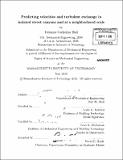Predicting velocities and turbulent exchange in isolated street canyons and at a neighborhood scale
Author(s)
Hall, Terianne C
DownloadFull printable version (15.62Mb)
Alternative title
study of fluid dynamics at the neighborhood scale
Other Contributors
Massachusetts Institute of Technology. Dept. of Mechanical Engineering.
Advisor
Leslie K. Norford.
Terms of use
Metadata
Show full item recordAbstract
Urban planners need a fast, simple model to assess the impact of early design phase iterations of neighborhood layout on the microclimate. Specifically, this model should be able to predict the expected urban heat island intensity and the locations in neighborhood layouts that are prone to pollutant retention. Current models are inadequate for this purpose because they use computationally intensive techniques to solve for flow through a neighborhood and often require a strong technical background for effective use of the models. In this thesis, we use analytical equations and empirical relationships to calculate the expected wind speeds in isolated, idealized street canyons. We demonstrate that flow in street canyons is driven by momentum exchange with the air above. We discuss the importance of flow separation and turbulent exchange between the urban canopy layer and the urban boundary layer for removing heat and pollutants from street canyons. Next, we introduce a method to parameterize this exchange and extend this work to more realistic street canyons and idealized neighborhoods. We evaluate this work using computational fluid dynamics and comparison to experimental results and models from the literature. We examine cases where the flow is influenced by buoyancy effects and assess the applicability of our work in these situations. Finally, we address how this work could be further developed into generalized planning guidelines and incorporated into a comprehensive model for urban planners.
Description
Thesis (S.M.)--Massachusetts Institute of Technology, Dept. of Mechanical Engineering, 2010. Cataloged from PDF version of thesis. Includes bibliographical references (p. 127-130).
Date issued
2010Department
Massachusetts Institute of Technology. Department of Mechanical EngineeringPublisher
Massachusetts Institute of Technology
Keywords
Mechanical Engineering.